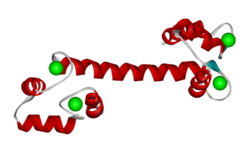User:Michael Roberts/BIOL115 CaM
From Proteopedia
| (8 intermediate revisions not shown.) | |||
| Line 11: | Line 11: | ||
Click on the ''' 'green links' ''' in the text in the scrollable section below to examine this molecule in more detail. | Click on the ''' 'green links' ''' in the text in the scrollable section below to examine this molecule in more detail. | ||
| - | <StructureSection load='1cll' size=' | + | <StructureSection load='1cll' size='600' side='right' caption='Structure of human calmodulin (PDB entry [[1cll]])' scene='User:Michael_Roberts/BIOL115_CaM/Wireframe/3'> |
== Molecular Model: == | == Molecular Model: == | ||
We'll start with a simple ball-and-stick representation of the protein. This shows all of the atoms that make up the protein and the bonds between them. | We'll start with a simple ball-and-stick representation of the protein. This shows all of the atoms that make up the protein and the bonds between them. | ||
| Line 49: | Line 49: | ||
== Binding to target proteins == | == Binding to target proteins == | ||
| - | '''INACTIVE CALMODULIN:''' | + | '''ACTIVE & INACTIVE CALMODULIN:''' |
| - | At resting levels of cytosolic Ca<sup>2+</sup> (~100 nM), calmodulin exists predominantly in the calcium-free form. This is called apo-calmodulin and <scene name='User:Michael_Roberts/BIOL115_CaM/Inactive_calmodulin/1'> | + | At resting levels of cytosolic Ca<sup>2+</sup> (~100 nM), calmodulin exists predominantly in the calcium-free form. This is called <scene name='User:Michael_Roberts/BIOL115_CaM/Inactive_calmodulin/1'>apo-calmodulin</scene> and its structure is more compact than the structure we saw earlier <scene name='User:Michael_Roberts/BIOL115_CaM/Structure_plus_c/3'>with bound calcium</scene>. Note the extended α-helix linking the two EF-hand-containing domains in the Ca-bound structure, which is interrupted in the <scene name='User:Michael_Roberts/BIOL115_CaM/Inactive_calmodulin/1'>Ca-free form</scene>. Here, the terminal helices are folded down concealing their hydrophobic surfaces and the central chain, which is not now α-helical along its whole length, is not exposed. |
| - | + | ||
| - | + | ||
'''CALMODULIN INTERACTS WITH ITS TARGET:''' | '''CALMODULIN INTERACTS WITH ITS TARGET:''' | ||
| - | The | + | The Ca<sup>2+</sup>-bound form of calmodulin with its exposed hydrophobic surfaces that you have already observed can <scene name='User:Michael_Roberts/BIOL115_CaM/Active_calmodulin/1'>interact with a target protein</scene>. It does this by wrapping around a specific sequence on the target molecule, which is then forced into an α-helical structure. |
The target molecule here (shown in blue) is the calmodulin-regulated enzyme, myosin light chain kinase. Only a short sequence from this protein, the calmodulin binding domain, is shown. | The target molecule here (shown in blue) is the calmodulin-regulated enzyme, myosin light chain kinase. Only a short sequence from this protein, the calmodulin binding domain, is shown. | ||
| + | |||
| + | In this view, <scene name='54/541097/Active_calmodulin/3'>polar and non-polar residues</scene> are coloured in order to highlight the hydrophobic interior of the molecule, which forms the binding site for the myosin light chain kinase calmodulin binding domain. | ||
| + | {{Template:ColorKey_Hydrophobic}}, {{Template:ColorKey_Polar}} | ||
</StructureSection> | </StructureSection> | ||
'''External Resources.''' | '''External Resources.''' | ||
| - | You can view a nice animation of the conformational change undergone by calmodulin upon calcium binding by following this link [http:// | + | You can view a nice animation of the conformational change undergone by calmodulin upon calcium binding by following this link [http://morph2.molmovdb.org/results.rpy?jobid=8350057535]. |
Current revision

Sequence and structure of EF hands
The EF hand motif is present in a many proteins and it commonly bestows the ability to bind Ca2+ ions. It was first identified in parvalbumin, a muscle protein. Here we'll have a look at the Ca2+-binding protein calmodulin, which possesses four EF hands. Calmodulin and its isoform, troponinC, are important intracellular Ca2+-binding proteins.
The structure below, obtained by X-ray crystallography, represents the Ca2+-binding protein calmodulin. It has a dumbell-shaped structure with two identical lobes connected by a central alpha-helix. Each lobe comprises three α-helices joined by loops. A helix-loop-helix motif forms the basis of each EF hand.
Click on the 'green links' in the text in the scrollable section below to examine this molecule in more detail.
| |||||||||||
External Resources. You can view a nice animation of the conformational change undergone by calmodulin upon calcium binding by following this link [1].
